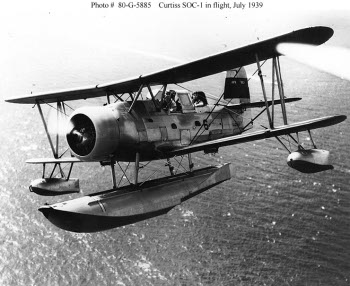![]() The Pacific War Online Encyclopedia
The Pacific War Online Encyclopedia
|
| Previous: SO Surface Search Radar | Table of Contents | Next: Soc Trang |

Curtiss SOC-3 Seagull
| Dimensions | 36' by 32'3" by 14'10" 10.97m by 9.83m by 4.52m |
| Wing area | 342 square feet 31.8 square meters |
| Weight | 3648-5302 lbs 1655-2405 kg |
| Maximum speed | 154 mph (248 km/h) at 5000 feet (1520 meters) 159 mph (256 km/h) at sea level |
| Landing speed | 55 mph 89 km/h |
| Climb rate | 16 feet per second 4.9 meters per second |
| Service ceiling | 14,200 feet 4330 meters |
| Power plant | 1 550 hp (410 kW) Pratt
& Whitney R-1340-22
engine |
| Armament | 1 0.30 fixed
nose machine gun with 550 rounds 1 0.30 flexible rear cockpit machine gun with 600 rounds |
| External stores | 2 116 lb (53kg) bombs or 1 325 lb (147kg) depth charge |
| Range | 840-1000 miles |
| Fuel | 140-70 gallons 530-265 liters |
| Production |
About 330 by 1938 |
The Curtiss SOC Seagull was the
standard seaplane used on U.S.
cruisers during
the Pacific War. It was equipped with folding wings to facilitate
storage in small cruiser hangars. Its floats could be swapped for
landing gear to allow it to operate from carriers and airfields.
The prototype first flew in 1934 and production
began the next year. Production ceased by 1938 and a replacement was
badly needed for the rapidly aging aircraft, but this failed to
materialize for some time. The monoplane OS2U Kingfisher was used on battleships, where folding wings
were not required, while the SO3C was a failure and the SC Seahawk did not come
out until quite late in the war.
References
Naval Historical Center (accessed 2009-11-6)
The Pacific War Online Encyclopedia © 2007, 2009 by Kent G. Budge. Index